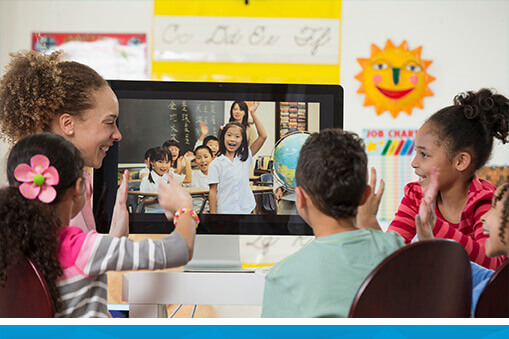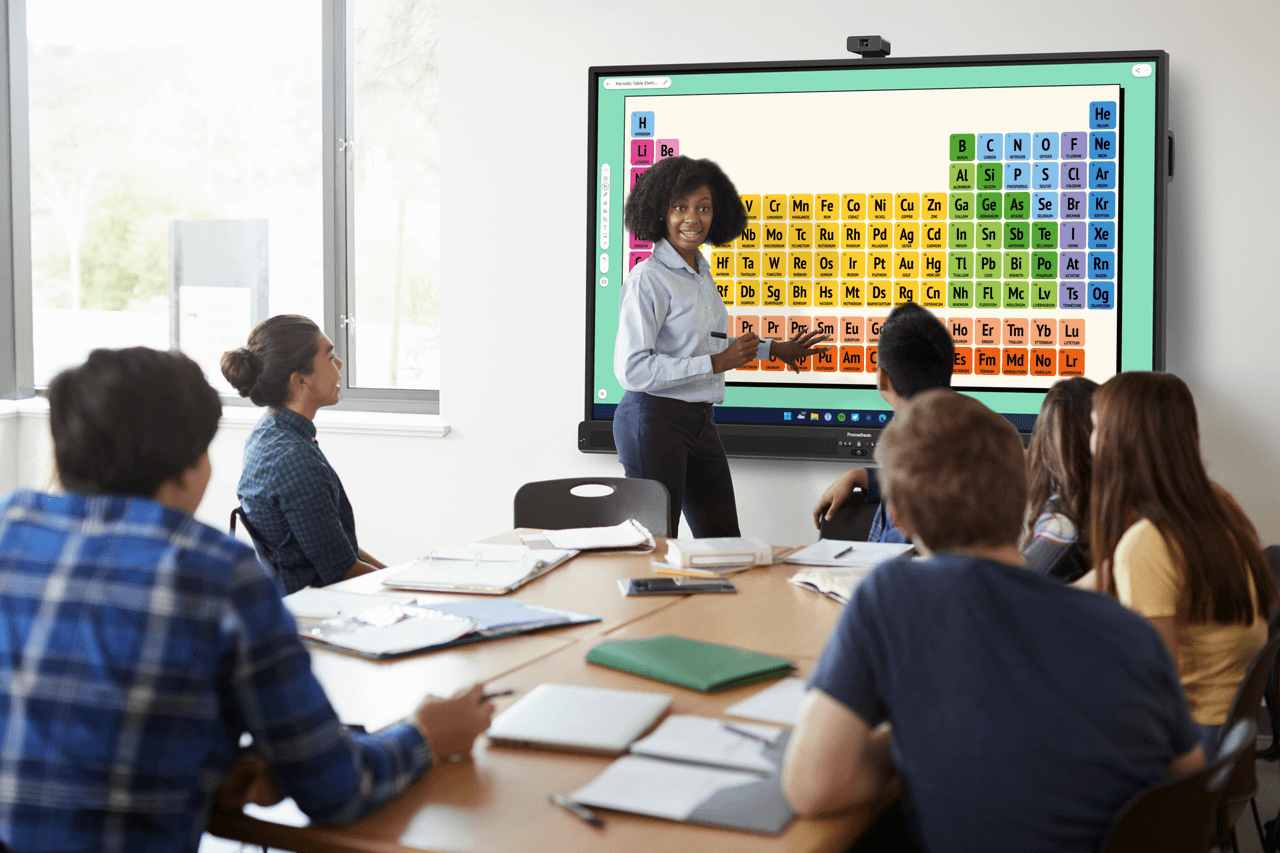Published on June 1st, 2021
How to build classroom culture across modalities
10 minute read

Classroom Culture Matters
Positive classroom culture is foundational to academic success and students’ social emotional learning (SEL); students thrive in a safe, inclusive, and supportive environment. But fostering a classroom culture across multiple learning modalities can be challenging.
It can be hard to create a sense of community and shared values when some students are learning in person and others are learning from home. Students at home may not feel the same sense of community they once did as in-person learners. And in-person students can feel disconnected from their at-home peers.
Building classroom culture where every student feels a sense of belonging requires planning and intentionality—and doing so across modalities will require some additional time and resources. But educators agree that creating a classroom where every student is heard regardless of where they’re learning from is well worth the effort.
-
Take Inventory
Begin by assessing the current state of classroom culture, asking yourself questions such as:
- How are students communicating with their teachers and each other? What language are they using to speak to their peers? Is it inclusive, supportive, and respectful?
- Are remote students as engaged with their peers as in-person students?
- Is every student being heard from consistently? Do students have equal opportunities to speak up in class?
- How are student successes acknowledged and celebrated?
- Do students have room to experiment? Do they feel safe trying and failing within the classroom community?
- Are remote students getting opportunities to engage informally/casually with their peers?
- What does an engaged, tight-knit class look like in the context of your school or district? How does your classroom compare?
- What classroom behavioral norms would support a more connected, engaged class?
- What strategies are you currently using to get to know your students better?
- Do students feel like they have a role in directing their learning experiences?
Use the questions above to take an honest look at culture in your classroom. Equipped with a clear understanding of where your classroom culture stands, set clear, actionable goals around areas of opportunity.
-
Pair Work
Peer-to-peer collaboration fosters a spirit of teamwork and gives students valuable opportunities to forge interpersonal connections. Bridge the gap between remote and in-person learners by pairing students in the classroom with students who are learning from home. Consider dedicating a quiet space in the classroom for students to video chat with remote partners and encourage students to collaborate with video on.
While it may be easier to pair up students according to their modalities, matching remote learners with remote learners and in-person learners with in-person learners, this can reinforce the divide between learning modalities. When in-person students are paired with remote students, kids are granted a valuable opportunity to connect and collaborate one-on-one, making the gap feel that much smaller.
-
Active Listening
Part of building healthy, positive classroom culture is ensuring that every student feels heard, no matter where they are learning from. This not only means making sure that every student has the chance to speak up and participate, but that when they do they are listened to and acknowledged.
Active listening may not come naturally to every student, but it is something that can be learned and practiced over time. Discuss what it feels like to be seen and heard as a class, and brainstorm ways to demonstrate attention, support, and respect. Let students lead the discussion. Invite them to come up with active listening strategies for virtual learning to ensure that students at home feel heard by students in school and vice versa. Ideas may include nodding or using hand signs to show agreement, or responding to a specific point a student made by chiming in on a group chat.
-
Fun Rituals, Traditions, & Celebrations
Celebrating a happy occasion can bring a class together and foster a strong sense of inclusion. Welcome students into the planning process, working with them to create a holiday calendar that’s representative of all students’ cultural and religious backgrounds. Give students the opportunity to teach the class about their respective holiday traditions, building respect, understanding, and appreciation for diversity.
Classes may also explore coming up with their own holidays; special celebrations that are unique to the class as a whole. Create a new, fun event to celebrate together, such as “Silly Hat Day” or “Dress Up As My Hero Day.” Other bonding rituals might include celebrating the first day of the month or a participatory game that’s played every Friday.
-
Let Students Take the Lead
Bridge the gap between remote and in-person learners by giving students at home the opportunity to direct students in the class. A remote learner may offer instruction to an in-person student at the whiteboard or interactive panel, for example, telling them how to solve a problem or interact with a piece of content.
Activities like this benefit classroom culture by building bonds between students in different modalities within the context of a shared learning experience. Students learning from home also get a chance to participate in the in-class experience to a greater extent, using another student as an avatar.
Experiment with other effective methods of student-led learning, such as a jigsaw activity. In a jigsaw activity, students are divided into groups and each group learns about one aspect of the subject matter. Then all students come together to learn from one another, piecing together the learning puzzle. Screen sharing offers students the opportunity to turn these group presentations into unique digital multimedia projects.
Pro tip: With Promethean ActivPanel, up to four students are able to screen share simultaneously. Challenge students to present their different screens together, each one showing a different piece of information. Extra credit goes to any team that gets their screens to interact!
-
Hands-On at School and Home
Shared tactile experiences can help bridge modality borders. Bring the class together with a hands-on project, such as designing a robot or a miniature boat.
Supply students with materials, sending packages to remote students so they have access to the same items as their in-class peers. Encourage in-person students and remote students to meet up virtually to exchange ideas and consult each other on their projects.
Conclude the assignment by inviting each student to make a video presenting their project and post it to a shared forum where their peers can comment and engage with their work from anywhere. Learning management systems (LMS) like those offered by Promethean make this experience seamless and cohesive.
The Unified Class
Classroom culture is the foundation on which healthy, supportive learning environments are built, and creating a sense of community at the classroom level is among educators’ biggest responsibilities.
Expanding classroom culture to encompass new and various learning modalities isn’t easy; additional thought and resources are required. This may mean stationing multiple cameras around the room to allow remote students to see the full class, incentivizing remote students to keep their videos on, or going to the extra effort to have all students, both in-person and remote, go on Zoom at the start of class for a quick all-class check-in.
But teachers don’t have to go it alone. Involving students in the process of envisioning, creating, and maintaining an inclusive, multimodal learning atmosphere is both helpful and essential. Whether it’s working with kids to brainstorm strategies for a more connected classroom or recruiting tech savvy students to support unification, building classroom culture is a community effort.
Multiple learning modalities appear to be here to stay and unifying classroom culture may be more important than ever before. Putting a strategy in place for building classroom culture across modalities now is an essential step towards ensuring that no student gets left behind.
To learn more about how Promethean can support students and teachers across learning modalities, schedule a live online demo today.




